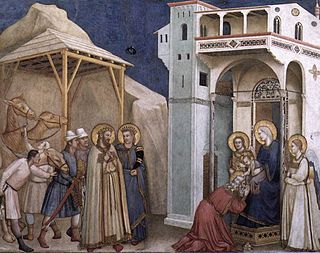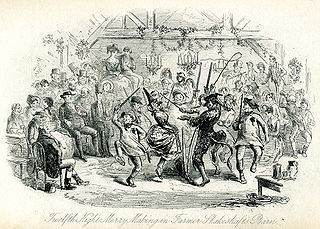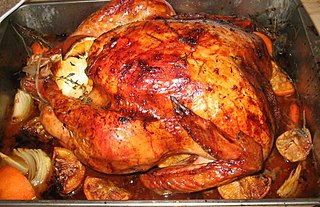Related Research Articles

The Day of the Dead is a holiday traditionally celebrated on November 1 and 2, though other days, such as October 31 or November 6, may be included depending on the locality. It is widely observed in Mexico, where it largely developed, and is also observed in other places, especially by people of Mexican heritage. The observance falls during the Christian period of Allhallowtide. Some argue that there are Indigenous Mexican or ancient Aztec influences that account for the custom, and it has become a way to remember those forebears of Mexican culture. The Day of the Dead is largely seen as having a festive characteristic. The multi-day holiday involves family and friends gathering to pay respects and to remember friends and family members who have died. These celebrations can take a humorous tone, as celebrants remember funny events and anecdotes about the departed.

Christmas Eve is the evening or entire day before Christmas Day, the festival commemorating the birth of Jesus. Christmas Day is observed around the world, and Christmas Eve is widely observed as a full or partial holiday in anticipation of Christmas Day. Together, both days are considered one of the most culturally significant celebrations in Christendom and Western society.

Mexico's culture emerged from the culture of the Spanish Empire and the preexisting indigenous cultures of Mexico. Mexican culture is described as the 'child' of both western and native American civilizations. Other minor influences include those from other regions of Europe, Africa and also Asia.

Las Posadas is a novenario. It is celebrated chiefly in Latin America, El Salvador,Mexico, Guatemala, Honduras, and by Latin Americans in the United States. It is typically celebrated each year between December 16 and December 24. Latin American countries have continued to celebrate the holiday, with very few changes to the tradition.

The Twelve Days of Christmas, also known as the Twelve Days of Christmastide, are the festive Christian season celebrating the Nativity.

A king cake, also known as a three kings cake, is a cake associated in many countries with Epiphany. Its form and ingredients are variable, but in most cases a fève such as a figurine, often said to represent the Christ Child, is hidden inside. After the cake is cut, whoever gets the fève wins a prize. Modern fèves can be made of other materials, and can represent various objects and people.

Christmastide, also known as Christide, is a season of the liturgical year in most Christian churches.

Twelfth Night is a Christian festival on the last night of the Twelve Days of Christmas, marking the coming of the Epiphany. Different traditions mark the date of Twelfth Night as either 5 January or 6 January, depending on whether the counting begins on Christmas Day or 26 December. January 6 is celebrated as the feast of Epiphany, which begins the Epiphanytide season.

Epiphany, or Eid al-Ghitas, also known as "Theophany" in Eastern Christian tradition, is a Christian feast day commemorating the visit of the Magi, the baptism of Jesus, and the wedding at Cana.

Christmas is one of the biggest holidays in the Philippines. As one of the two predominantly Catholic countries in Asia, the Philippines celebrates the world's longest Christmas season ; Christmas music is played as early as August. The holiday season gradually begins by September, reaching its peak in December during Christmastide, and concludes within the week after New Year's Day, more specifically on the Sunday of Epiphany; however, festivities could last until the third Sunday of January, the feast day of the Santo Niño de Cebú. Liturgically, the Christmas season is observed by the Catholic Church in the Philippines from Christmas Day to the Feast of the Baptism of the Lord.

The observance of Christmas around the world varies by country. The day of Christmas, and in some cases the day before and the day after, are recognized by many national governments and cultures worldwide, including in areas where Christianity is a minority religion. In some non-Christian areas, periods of former colonial rule introduced the celebration ; in others, Christian minorities or foreign cultural influences have led populations to observe the holiday.
Litany Para Pedir Posada is a song traditionally sung in The Posadas — traditional Christmas celebrations in some Spanish-speaking Latin American countries. In Mexico, posadas are part of what has recently been called The Guadalupe-Reyes Marathon.

Jul or jol is the term used for the Christmas holiday season in Scandinavia and parts of Scotland. Originally, jul was the name of a month in the old Germanic calendar. The concept of jul as a period of time rather than a specific event prevailed in Scandinavia; in modern times, jul is a period of time stretching from the fourth Sunday before Christmas Eve, December 24, to (traditionally) mid-January at the date of Epiphany with the month of December and Christmas, and the week up to the New Year, as its highlight. The modern English yule and yuletide are cognates with this term.

Christmas dinner is a meal traditionally eaten at Christmas. This meal can take place any time from the evening of Christmas Eve to the evening of Christmas Day itself. The meals are often particularly rich and substantial, in the tradition of the Christian feast day celebration, and form a significant part of gatherings held to celebrate the arrival of Christmastide. In many cases, there is a ritual element to the meal related to the religious celebration, such as the saying of grace.

Candlemas, also known as the Feast of the Presentation of Jesus Christ, the Feast of the Purification of the Blessed Virgin Mary, or the Feast of the Holy Encounter, is a Christian feast day commemorating the presentation of Jesus at the Temple by Joseph and Mary. It is based upon the account of the presentation of Jesus in Luke 2:22–40. According to the Old Testament rules in Leviticus 12, a woman was to be purified by presenting a lamb as a burnt offering, and either a young pigeon or dove as sin offering, 33 days after a boy's circumcision. The feast falls on 2 February, which is traditionally the 40th day of and the conclusion of the Christmas–Epiphany season.

The Christmas season or the festive season; also known as the holiday season or the holidays, is an annual period generally spanning from late November to early January. Incorporating Christmas Day and New Year's Day, the various celebrations during this time create a peak season for the retail sector extending to the end of the period. Christmas window displays and Christmas tree lighting ceremonies are customary traditions in various locales.

The Cavalcade of Magi is a traditional parade with floats carrying the wise men taking place in practically all Spanish cities and villages, in Andorra and Argentina, in some cities and towns in Mexico and Gibraltar. The Magi ride through the streets, as their pages collect children's letters to the kings and also throw candy to children. The cavalcade usually includes dancers, musicians, and pages, as well as other assistants to the kings.
Lists of holidays by various categorizations.

Christmas in Mexico is observed from December 12 to January 6, with one additional celebration on February 2. Traditional decorations displayed on this holiday include nativity scenes, poinsettias, and Christmas trees. The season begins with celebrations related to the Virgin of Guadalupe, the Patroness of Mexico, followed by traditions such as Las Posadas and Pastorelas.
References
- ↑ Orlando R. Kelm; Olivia Hernandez-Pozas; David A. Victor (3 February 2020). The Seven Keys to Communicating in Mexico: An Intercultural Approach. Georgetown University Press. pp. 94–. ISBN 978-1-62616-724-7.